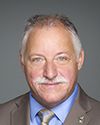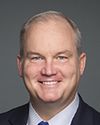Thank you, Mr. Chair, and members of the Standing Committee on Veterans Affairs.
Thank you for the opportunity to be here today, along with my colleague from Veterans Affairs Canada, to speak on the subject of transition.
As commander of the joint personnel support unit, I'm responsible to ensure that the ill and injured Canadian Armed Forces personnel, former personnel, their families, and families of the deceased are properly cared for and receive administrative support during all phases of recovery, rehabilitation, and reintegration, whether they are returning to service or transitioning to civilian life. This is accomplished through an integrated team with Veterans Affairs Canada and approximately 400 Canadian Armed Forces military and Department of National Defence civilian staff members on bases, wings, units, and at the joint personnel support unit headquarters here in Ottawa.
As commander of the joint personnel support unit, in addition to an overall emphasis on continuous improvement, my top priorities are caring for and supporting our ill and injured members and their families, renewing the joint personnel support unit, and planning for the future transition group, while working closely with Veterans Affairs Canada.
As background, the Joint Personnel Support Unit, the JPSU, was created in 2009 to give ill and injured members the opportunity to recover, to return to duty, or to give them time and support to transition to civilian life.
The number of JPSU supported members has nearly tripled in size since its creation. Today, approximately 1,500 ill and injured personnel are currently posted to the JPSU for periods of six months or more. The JPSU also directly supports approximately 4,000 additional ill and injured members and their families by providing information, advocacy, referrals, and the delivery of numerous services and programs.
This support takes place across Canada at the JPSU's 31 integrated personnel support centres. These IPSCs are the local face of the joint personnel support unit, providing a one-stop centre delivering integrated assistance to the ill and injured.
My top priority is providing care and support to the ill and injured members and their families. The Department of National Defence and the Canadian Armed Forces are committed to the care and well-being of all military personnel and their families. Part of that commitment is provided through the JPSU, ensuring that no one is released until all administration is complete and appropriate benefits are in place. All transitioning members require support, but the needs remain most acute for our ill and injured posted to the JPSU. Improving our daily support and service is an ongoing effort. One very recent and tangible example of this support was the acquisition of 17 new wheelchair-accessible vans that were delivered to integrated personnel support centres across the country in January. An additional 16 wheelchair-accessible vans were provided to various bases. These vans will increase transportation capability and support ill and injured Canadian Armed Forces members in getting to and from their medical appointments.
While the JPSU has assisted numerous ill and injured women and men over the years, there is room for improvement. That's why my second priority is JPSU renewal. The JPSU has grown and is currently undergoing a renewal to better meet its core mandate of service to our ill and injured members.
The JPSU has been organized as a formation with a general officer—myself, currently—at its head. While retaining its regional structure, JPSU regional headquarters have become units with designated commanding officers and more authority and responsibility to have a positive influence on members. These commanding officers will be “up-ranked” shortly in some regions from majors to lieutenant-colonels to better highlight their important responsibilities in working with Canadian Armed Forces, Veterans Affairs, and other partner organizations to assist and support our ill and injured members.
At our IPSCs across the country, there has been an increase of staff to better meet the demand in services. In 2017, 31 regular force members were added and funding was secured for 28 more civilian staff. The year 2018 will bring further augmentation to our staff to provide better support and more favourable ratios. As a direct result of this staffing, we are hoping to achieve a ratio of one section commander for every 20 personnel posted to the JPSU, as opposed to one for every 26 currently. What this will mean in practical terms is better oversight, support, and personalized service for all ill and injured posted to the JPSU.
In addition, JPSU headquarters is undergoing reforms to its structure to prioritize the effort on transition services. These changes put in place a director of transition services to continue efforts to focus priority on transition programs and services.
My third priority is the creation of the Canadian Armed Forces transition group. As you are aware, in June 2017 the government introduced Canada's new defence policy of “Strong, Secure, Engaged”, setting out defence objectives for the next 20 years. Since it was released, we've been busy planning for a new transition group, which will be established over the next few years to provide professional, personalized, and standardized support to all Canadian Armed Forces members to seamlessly transition to post-military life and to ensure all benefits are in place before their transition, with particular attention paid to our ill and injured members. Support will also be provided to former veterans and their families to facilitate integration back into civilian life after service.
Professional support means a transition group that is adequately resourced, with personnel in place who are properly trained. It also means a deepening integration with Veterans Affairs Canada to provide more closely coordinated service.
Personalized means a needs-based approach, which tailors services to the individual and their family needs.
Finally, standardized means that the same services are available to every member of the military and their family, whether reserve or regular force, from Esquimalt to St. John's, as they experience transition.
This is an ambitious and complex undertaking that will take some time to build. However, in order to advance it, we will begin a trial this year in Borden, which will allow us to implement some new initiatives with an opportunity to test and adjust them prior to implementing them Canadian Armed Forces-wide.
Finally, tying these priorities together is an ongoing effort, a commitment to implementing continuous improvement while deepening integration with Veterans Affairs Canada. As transition is a shared responsibility between the Canadian Armed Forces and Veterans Affairs Canada, close coordination and integration between both departments is vital in ensuring a successful and seamless transition from military to civilian life. Together with VAC, we've made improvements and continue to improve programs and services, and we have introduced new programs and services that are more aligned between the two departments.
The goal is to better enable our people to successfully transition to civilian life through enhancing training and readiness, promoting recruitment and employment, and nurturing collaboration among those in the veteran employment community. This close collaboration is ongoing. For example, the Veterans Affairs Canada and Canadian Armed Forces seamless transition task force has been established to ensure early intervention, continuity in health care and support, and simplification of processes. This work includes, for example, advancing an integrated case management model, improving alignment between the departments' health benefits, and developing new transition tools focused on overall well-being.
In summary, my goal, the goal of the JPSU, and the goal of the future transition group is to ensure all members and their families are informed, prepared, and empowered to conduct a successful transition. Many of the pieces for a successful transition are already in place or being put in place. Timing, communication, and access to these pieces is in the process of being improved. New support services and programs are being put into place where required, and planning toward the stand-up of the transition group is under way. This stand-up will require a commitment of time and resources over the next few years, in particular men and women who are devoted to providing support to others in helping them achieve their transition goals. This commitment is of vital importance, as nothing is more important to the Canadian Armed Forces than the well-being of our people and their families.
Mr Chairman, thank you for the opportunity to appear today. I would be pleased to respond to any questions.










